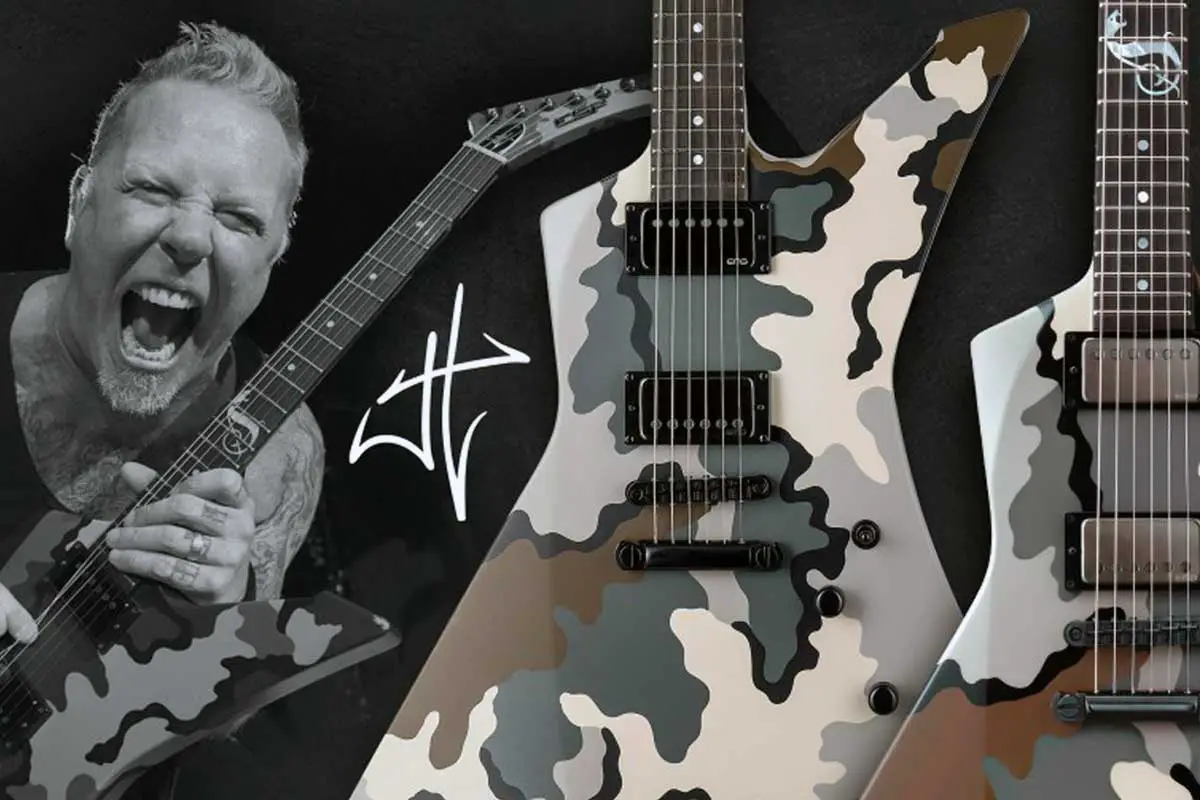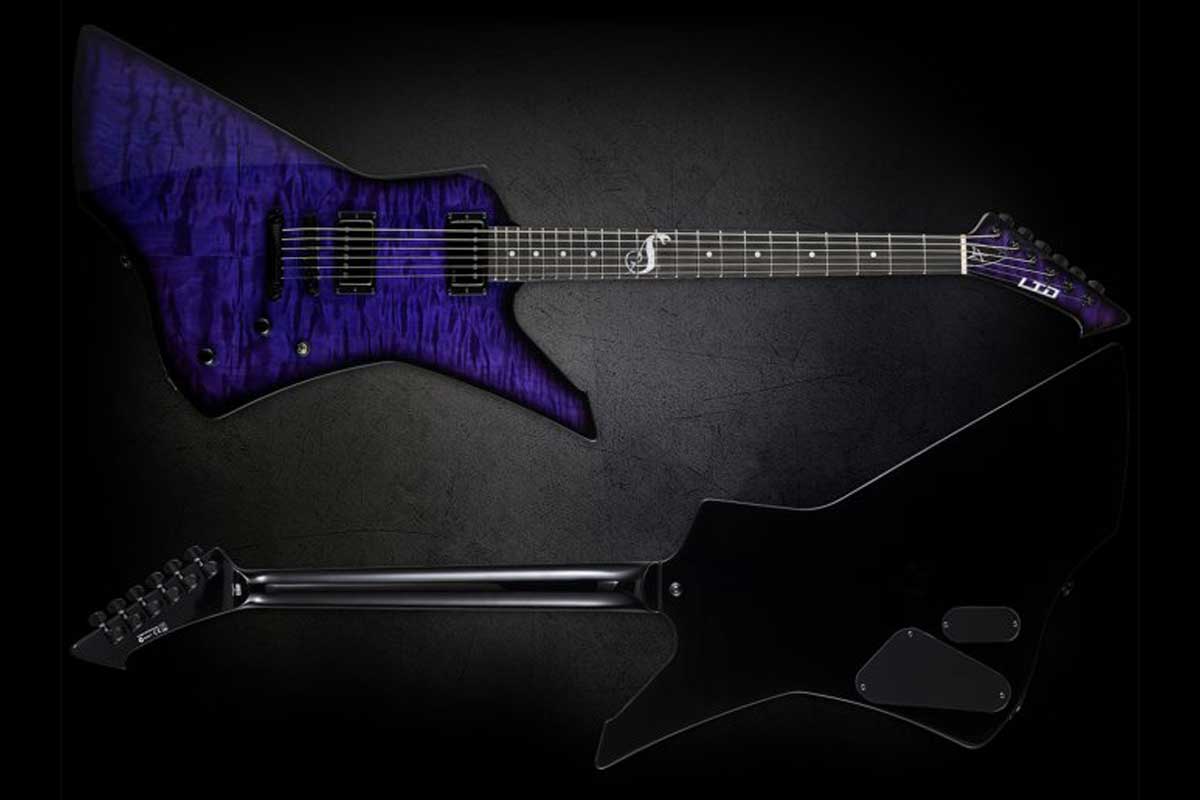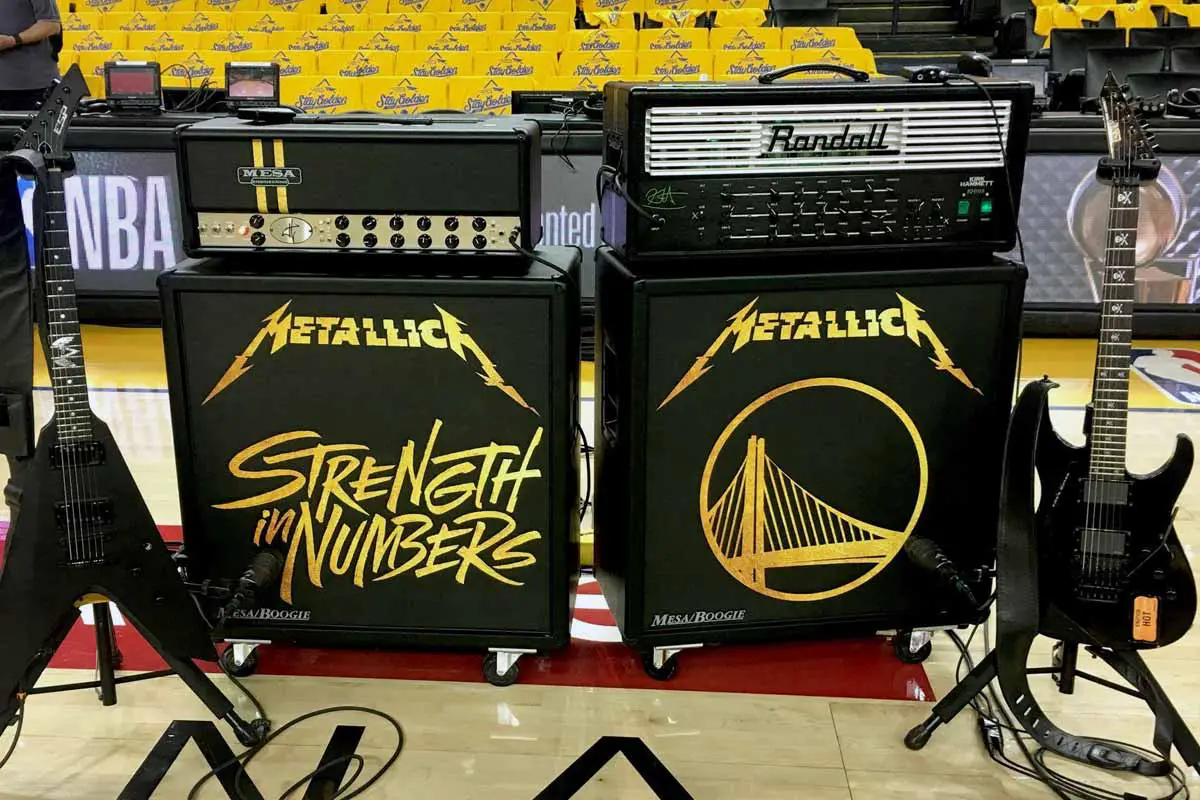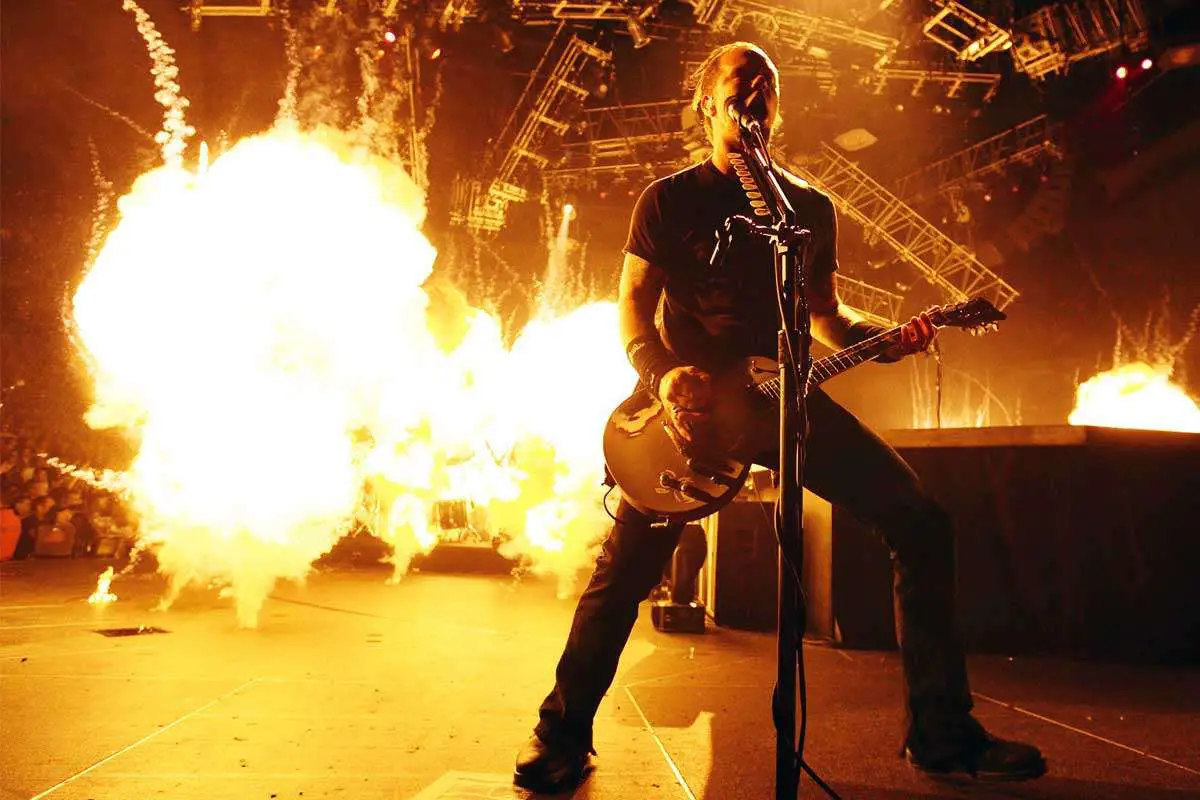James Hetfield, frontman of the iconic band Metallica, is not only renowned for his powerful vocals but also for his distinctive rhythm guitar playing. But what guitar does James Hetfield play and what other gear does he use to achieve his distinct tone? Throughout his career, he has been associated with various guitar brands, most notably ESP Guitars. Since the 1980s, Hetfield’s choice of instruments has played a crucial role in shaping the heavy metal sound that Metallica is famous for. His use of ESP guitars and the development of signature models reflect his influence on music gear culture.
Hetfield’s approach to his sound is characterized by heavy riffs and precision timing, requiring guitars that meet his standards for sound quality and durability. The customizations on his guitars, including specific pickups and strings, contribute to his unique tone. In addition, his amplification and effects gear have evolved over the years to capture the evolving Metallica sound. His gear choices have had a significant impact, influencing both fans and fellow musicians in the metal genre.
Key Takeaways
- James Hetfield favors ESP Guitars, contributing significantly to his metal rhythm guitar sound.
- Hetfield’s gear customizations, including pickups and strings, are integral to his tone.
- Hetfield’s equipment preferences have shaped his musical impact within the heavy metal scene.

James Hetfield and his Iconic Guitars
James Hetfield, the co-founder and frontman of Metallica, is recognized for his powerful rhythm guitar playing. Known for his precision and heavy riffing, Hetfield has popularized several models, including the Gibson Explorer and various ESP electric guitars.
Main Guitars Used by Hetfield
- Gibson Explorer: This guitar is synonymous with Hetfield’s crunchy, aggressive playing style. It gained prominence in the 1980s and has remained one of his main guitars. The classic design and robust sound fit perfectly with Metallica’s heavy metal sound.
- ESP Guitars: In collaboration with ESP, Hetfield has designed his signature series, including the recognizable “Snakebyte”. Technically refined and aesthetically bold, these guitars reflect Hetfield’s personal style and the demands of Metallica’s music.
- ESP Explorer: Hetfield personalized these guitars to his own specifications, making them distinct with custom inlays, finishes, and hardware, which have played a pivotal role in his performances and recordings.
Each guitar, from the iconic Gibson Explorer to the customized ESP models, showcases Hetfield’s dedication to his craft and influence in shaping the sound of heavy metal guitar.
Related: Other famous guitarists
Signature Models and Customizations

James Hetfield, the frontman of Metallica, is known for his unique guitar play style, and his instruments reflect this through exclusive signature models and customized features.
ESP Signature Series
ESP Guitars has collaborated closely with Hetfield to create a range of signature models that cater specifically to his heavy metal tone and playing style. The ESP James Hetfield Snakebyte is a distinctive model that’s quickly recognizable with its sharp and angular design, a departure from the traditional ESP shapes. This guitar, along with the ESP James Hetfield Snakebyte Custom Baritone, is designed to deliver the depth and clarity required for Hetfield’s rhythm playing in lower tunings. Both models typically feature a mahogany body and neck, providing a warm and resonant tone that’s a staple in Hetfield’s sound.
Another notable model is the ESP James Hetfield Iron Cross. It draws its aesthetic from a customized ESP Eclipse but stands out with its namesake Iron Cross artwork. These signature series guitars often come equipped with EMG James Hetfield Signature humbuckers, which offer a blend of aggression and definition suitable for Hetfield’s precise riffing and melodic solos.

Related: What is a baritone guitar?
Unique Features and Customizations
Customization is key to achieving Hetfield’s iconic sound. Several of his guitars have unique features to accommodate his playing technique and sound preferences. For instance, the custom Flying V model, not typically found in Hetfield’s public signature lineup, showcases his personal flair in instrument design. This guitar and others may feature a bubinga top, known for adding to the guitar’s visual appeal and tonal richness.
Favored for its smooth feel and tonal characteristics, an ebony fretboard is another common aspect of Hetfield’s guitars, providing sharp attack and sustain for lead playing. The guitars are set up with heavy gauge guitar strings to maintain tension even in lower tunings, which is essential for the tight rhythm parts Hetfield is renowned for. Beyond the hardware, Hetfield’s customizations extend into the aesthetics, from unique inlays to personalized finishes, making his instruments not just tools of the trade, but also personal statements.
Amplification and Effects Gear
James Hetfield’s iconic sound is shaped not just by his playing technique but also by a distinct selection of amplifiers and effects gear that create his heavy, rhythmic guitar tones.

Hetfield’s Amplifiers
James Hetfield has famously used various Mesa Boogie amplifiers throughout his career. The Mesa Boogie Mark IIC+ has been a staple in his rig, renowned for its thick, overdriven sound, which is essential to the band’s recordings and live performances. He has also harnessed the massive power of the Mesa Boogie Triple Rectifier, which provides a dense, high-gain sound. In addition to Mesa Boogie, Hetfield has implemented the Diezel VH4 for its versatile tone and the Marshall JCM800, which contributed to Metallica’s earlier tones. For a more nostalgic flavor, the Marshall JMP 2203 offers a classic feel. Further versatility in Hetfield’s sound comes from the Mesa Boogie Mark V and Wizard Modern Classic, both of which are known for their robust and dynamic range.
Essential Effects and Pedals
A critical aspect of James Hetfield’s sound comes from his thoughtful use of effects pedals. The Ibanez TS9 Tube Screamer is a key element for boosting solos and creating smooth sustain, while the ProCo Rat provides a distinct distortion that complements his heavy riffing. The Klon Centaur overdrive, although a rare piece, adds a mythical touch with its transparent and harmonically-rich drive. For modulation and space, the Line 6 DL4 Delay Modeler offers a variety of echoes and time-based effects. The Digitech Whammy pedal showcases Hetfield’s creative pitch-shifting, heard on tracks such as “The Unforgiven”. For maintaining tight control over noise, the Boss NS-2 Noise Suppressor is an indispensable tool in his chain. Given Metallica’s dynamic range in music, the Line 6 DM4 Distortion Modeler provides a variety of distortions to suit each song’s character. Lastly, for a unique fuzz, the Lovetone Brown Source enriches the palette of sounds at Hetfield’s disposal.
Each piece of gear is carefully selected and dialed in to contribute to the Metallica frontman’s legendary sound.
Pickups and Strings: Crafting Hetfield’s Tone
James Hetfield’s distinctive sound is a product of his meticulous selection of pickups and strings, blending precision and aggression into a sonic identity that has become iconic in the metal genre.
Signature Pickups
Hetfield’s quest for the perfect tone has led him to equip his guitars with high-output pickups, notably the EMG 81/60 set. The EMG 81 is often featured in the bridge position, known for its thick, precise tone that cuts through even the heaviest distortion with tight bass response and a slicing high-end. Meanwhile, for a more rounded and warm sound in the neck position, the EMG 60 is a frequent choice, allowing Hetfield to switch to clean and melodic passages without losing clarity.
Another favorite of Hetfield is the Seymour Duncan Invader pickups, which are notable for their high-output and expansive tone that enhances his guitar’s natural aggression. The Invaders are characterized by their oversized metal oxide poles and ceramic magnets, creating a massive sounding tone that has made them a fitting choice for Hetfield’s rhythm playing.
- Preferred Pickup Positions:
- EMG 81: Bridge
- EMG 60: Neck
- Seymour Duncan Invader: Bridge
Choice of Guitar Strings
String gauge is a key component in achieving Hetfield’s precise chug and sustaining solos. Over the years, he transitioned to lighter strings, finding that heavier gauges hindered his ability to perform his signature bends and vibrato. His playing utilizes a combination of light top/heavy bottom strings to maintain tightness in the low end while enabling flexibility for lead work.
Moreover, Hetfield’s picking technique is integral to his sound, often employing a Dunlop Tortex .88mm guitar pick. This particular pick strikes a balance between firmness and flexibility, complementing his aggressive down-picking style while facilitating speedy alternate picking and intricate solos.
- String Preferences:
- Gauge: Light top/heavy bottom
- Pick: Dunlop Tortex .88mm
Hetfield’s gear choices are a testament to his dedication to crafting a sound that is both massive and precise, ensuring every riff and solo is delivered with maximum impact.
Hetfield’s Impact on Metal Music

James Hetfield, co-founder and rhythm guitarist of Metallica, has undoubtedly left an indelible mark on metal music. His unique approach to guitar playing, characterized by a precise and aggressive use of distortion, has influenced a generation of musicians.
Influence of Metallica’s Sound
Metallica, since its inception in 1981, has been instrumental in shaping the sound of metal music. Hetfield’s rhythm guitar work on Metallica’s early albums, especially Kill ‘Em All, introduced a new level of vigor and tightness to the metal genre. His down-picking technique paired with thick distortion became a hallmark of Metallica’s sound and inspired countless guitarists to emulate his style.
The Master of Puppets album saw Hetfield’s guitar work becoming more sophisticated, combining complex arrangements with raw power. This album, along with “…And Justice for All,” showcased his ability to create heavy yet melodic riffs that would become central to Metallica’s identity and the genre at large.
Throughout their career, Metallica released numerous studio albums and music videos, each contributing to the metal landscape. Their videos often highlighted Hetfield’s commanding stage presence and guitar prowess, further solidifying his influence in the genre. Metallica’s sound, driven by Hetfield’s guitar, is credited with helping to bring metal music to a broader audience and redefining the boundaries of the genre.
